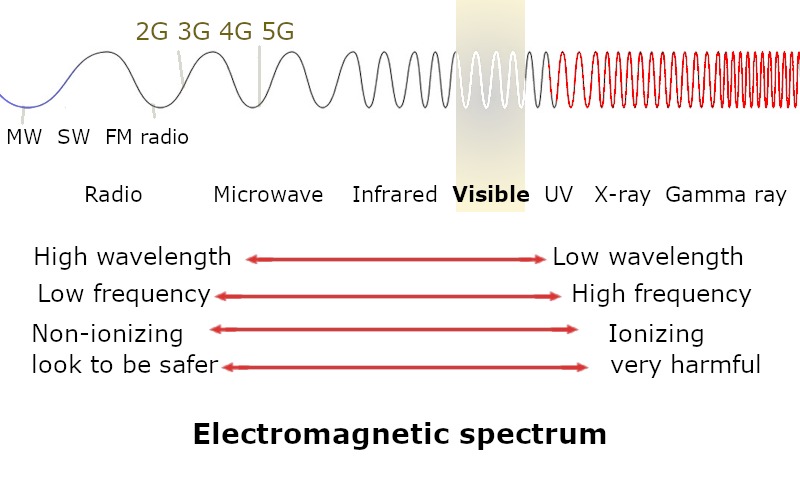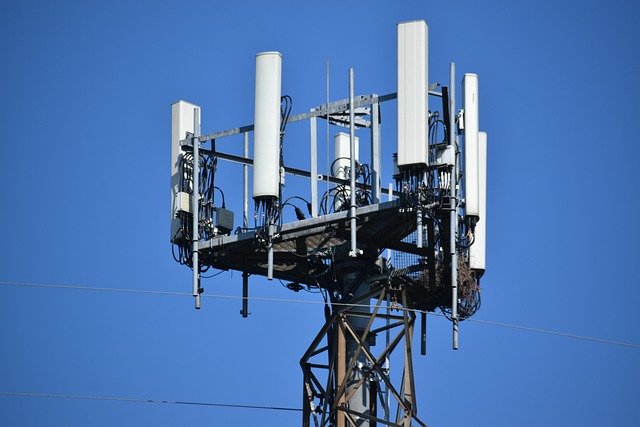Manoj Pandey*
Wireless communication happens through electromagnetic waves, and waves have peaks and troughs. So, let me start this article with two extreme views from knowledgeable sources about the impact of electromagnetic waves on humans.
“Numerous recent scientific publications have shown that EMF affects living organisms at levels well below most international and national guidelines. Effects include increased cancer risk, cellular stress, increase in harmful free radicals, genetic damages, structural and functional changes of the reproductive system, learning and memory deficits, neurological disorders, and negative impacts on general well-being in humans. Damage goes well beyond the human race, as there is growing evidence of harmful effects to both plant and animal life.”
The above is the stand of about 240 scientists who appealed to the UN bodies in 2015, alerting them about the impact of radiations caused by humans. After a renewed appeal in 2017, they made a specific request to UNEP in 2019 to assess the impact of 4G and 5G communication technologies. Calling their impact as “rapidly escalating health and environmental crisis caused by man-made EMF pollution,” the group called upon the UN to bell the cat: “Leadership is needed now, especially in light of urgent warnings from international scientists about 4G/5G antenna densification, the Internet of Things (IoT), and plans for significant radiation from space emitted by tens of thousands of satellites now being launched.”
Now look at the other side of the spectrum: An article in Forbes has to say this on 5G radiation: “With each new generation of WiFi that comes out, a new wave of fearmongering health claims emerges… If you’re not afraid of coffee or thyme, or getting a nickel with your change, you shouldn’t be afraid of 5G, or WiFi radiation in general… There are countless real hazards out there in the world, but 5G — much like vaccines, fluoridated drinking water, and the vapour trails left by aeroplanes — aren’t among them. In the search for truth, society should rely on the full suite of scientific evidence, rather than fear or ideology, to guide us.”
So, what is the truth?
Let us begin with the basics of 5G radiation.
Radiation is what radiates from objects, and it happens to be some form of energy emanating in the form of waves. Since the energy has electric and magnetic properties, it is called electromagnetic radiation.
These waves have an intrinsic property: the shorter the waves, the faster they complete a cycle of up and down and the higher amount of energy they carry; and the other way round. So, at one end of the electromagnetic spectrum lie very long waves, as of Medium Wave radio, and at the other end are very short waves, as of Gamma rays. The light rays that our eyes use for seeing the world come in the middle of this wide spectrum.
Since some energy is contained in all types of rays, the rays transfer a part of it to the surface on which they fall. Long, low-energy waves, can produce heat on getting absorbed, and are too weak to cause major harm to living tissues – according to the present knowledge. In contrast, the high energy contained in short waves is extremely harmful for living beings because it can ionize the chemicals in cells, mutate the genetic material, cause cancer and even kill cells.

Let me introduce a term here, for those not too familiar with it: frequency. It is the number of cycles of up-and-down a wave completes in a given time. A cycle completing in a second is called a Hertz; a thousand cycles in a second is a Kilohertz (KHz), a million cycles a second is a Megahertz (MHz) and a billion cycles a second is a Gigahertz (GHz).
As the picture above shows, radio waves are long, have low frequencies and carry less energy. Within the radio segment, frequencies higher than those used in radio broadcasts (0.3 to 3 KHz) are the frequencies used in television and mobile communication. While those used in 2G-4G communication are in the range of 300 KHz to 3 MHz, those used in 5G communication range from below 1 MHz to many GHz. Definitely, mobile frequencies are much higher than those used in radio communication.
Another property of electro-magnetic waves is that the higher their frequency, the less distance they can travel because they lose their energy fast. That is why FM broadcasts can be received in a much smaller area than long wave radio broadcasts, and many more mobile towers are required for 5G communication as compared to 2G, etc.
5G is safe, and science says so.
The frequencies of mobile radiation, including 5G radiation, are so low that when the waves are absorbed by human skin, they produce localized heat in a fraction of a millimetre thick tissue. That seems insignificant if we consider the heat coming from hot air produced in natural and artificial ways, and direct sunlight. These waves, thus, cannot get absorbed by brain and other internal organs.
The frequencies used in mobile communication are much below the human exposure limits specified by the International Commission on Non-Ionizing Radiation Protection (ICNIRP). There are many parameters related to radiation from handsets, that from towers, absorption by human body, etc recommended by this agency, and adopted by WHO and national authorities, sometimes with minor modifications.
The International Agency for Research on Cancer (IARC) classifies the electromagnetic fields produced by mobile phones as ‘possibly carcinogenic to humans’ which have a very low level of risk. In fact, alcoholic beverages, smoke and vehicle exhaust come much higher in the list of carcinogens.
It is also to be noted that even if the radiation levels may be high at the transmitter mounted on towers, they go down very sharply even a few meters away, and the height of these towers keeps them away from close human encounter.
Most scientific studies so far have been on 2G – 4G frequencies. However, inferences can be drawn for 5G as the 5G spectrum is not too far from that of 4G. These studies have not proved that radio frequencies cause health hazards to humans.
Animal studies conducted long ago showed links between continued high doses of exposure and diseases, but such extreme conditions are not encountered in human lives. In addition, at least some of these studies were not conducted by following set scientific procedures.
Population level studies in humans have not found a causal link between exposure to radio frequencies and diseases. A 2000-2012 study across 13 countries and many others have found no correlation with alleged tumours, etc with use of mobile phones.
Some studies have reported conflicting findings, especially relating to brain tumours, and the causation of tumours due to exposure to radiation has not been unequivocally established.
Though some users have reported headache, migraine, dizziness and other similar symptoms after heavy use of mobile phones, there is no scientific proof that these occur due to exposure to mobile radiation.
Recent studies have shown that tissue heating is not significant even with radio waves of higher frequencies.
A 2019 review of available scientific research revealed that the studies have been sketchy and the millimetre-wave radiation (which is part of 5G frequency range) has not been studied at all. A 2021 review of 107 scientific studies did not find enough evidence to confirm that 5G radiation can be hazardous to human health.
It is argued that in the implementation of 5G, there is much higher level of risk-mitigation built into design, cell architecture, network and regulations. It is also notable that 5G reduces the necessity to bring mobile devices close to the body because 5G is used for transmission of and videos more than phone calls.
Opposite viewpoints getting ignored?
This article started with a fervent appeal for studying the effects of electro-magnetic radiation caused by human activities and for pausing the implementation of 5G. The arguments and concerns put forth by these scientists and others are not fully devoid of merit. It is perhaps not in the true spirit of scientific inquiry to dub all such views as conspiracy theories and fearmongering.
Let us first have a look at the extreme views. During the early months of COVID-19 pandemic, it was widespread on social media that 5G radiation was the cause of the disease. There were claims that more cases of diseases, including coronavirus and brain tumours, have been observed near 5G towers. Such stories, which are still making rounds on the social media, often come with associations that look scientific to the gullible, e.g. 5G radiation can break human DNA, its frequency matches that of virus RNA, it kills immune cells and reduces immunity, and it sucks oxygen from the air. These are cases of fake news and need to be debunked.
It is also reported that a sizable segment of population feels that 5G has the potential to harm human health. Even without any evidence in hand, some seem to feel that because it is a new technology and stronger than earlier ones, it has to be harmful. Less visibility of bees, butterflies and birds in urban areas is also sometimes attributed to cellular radiation. Possible reasons for this are said to be disturbance in sense of direction, vision impairment, discomfort and overall reduction in their health. A 2020 Deloitte poll in 14 advanced countries found that people ranging from 5% to 36% in these countries believe that there are health risks associated with 5G.
Let us now see why some scientists do not believe the mainstream scientific arguments that mobile radiation is safe and 5G is no exception.
One refrain of dissenting scientists is that the results of all studies are considered invalid by mainstream science, and ignored by regulatory authorities. They point to some studies that prove a link between exposure to electromagnetic radiation and diseases, which may or may not be highly correlated – and associations are hardly ever correlated hundred-percent. In fact, classification of radio frequency radiation in ‘possibly carcinogenic’ by IARC itself is a proof that such frequencies are not above board, they say, and want IARC to put this radiation in a higher category of ‘probably carcinogenic’.
Regarding lab experiments with high and continuous doses that have shown development of malignancy in animals, the argument is that if such high doses do cause cancer, lower doses may have the potential to cause cancer at levels that would not manifest immediately. After a level of constant exposure, as is happening in today’s conditions, this seemingly harmless radiation might either directly cause health issues or increase the risk caused by other factors. Therefore, it is necessary that thorough studies are conducted at large scale before the entire human race is put to a silent disease burden.
The maximum permissible limits of radio frequency exposure (up to 300 GHz) are also based on limited data and understanding of possible risks. ICNIRP, the body that has recommended these limits, itself says this: “Induction of cancer from long-term EMF exposure was not considered to be established, and so these guidelines are based on short-term, immediate health effects such as stimulation of peripheral nerves and muscles, shocks and burns caused by touching conducting objects, and elevated tissue temperatures resulting from absorption of energy during exposure to EMF. In the case of potential long-term effects of exposure, such as an increased risk of cancer, ICNIRP concluded that available data are insufficient to provide a basis for setting exposure restrictions, although epidemiological research has provided suggestive, but unconvincing, evidence of an association between possible carcinogenic effects.” It is argued that these limits need a downward revision.
Let me mention here some oft-quoted research pointing towards a causal link of radio frequencies with health issues.
In a study, male rats developed tumours when exposed to high levels of radiation for a long period. Another piece of research suggested that constant use of mobile phones and cordless phones causes glioma, a type of brain tumour.
The impact of radio frequencies on animals have been documented in many research papers. Honey bees have been found to show aggressive behaviour, reduced productivity, swarming and abandoning. Birds have been found to suffer from impaired reproduction and interference with migration. Other living beings including amphibians, livestock and plants have been studied, and they were found to develop health issues when exposed to man-made electromagnetic radiation
Among humans, changes in brain activity and sleep patterns have also been found in some studies.
Another point to keep in mind is that man-made electromagnetic radiation around us is already enormous. Electricity produces a magnetic field around it, and together they produce an electromagnetic field around power lines and devices that use power. A good number of household and office devices including computers, television sets, air conditioners, kitchen and bath equipment produce electromagnetic fields. Bluetooth, remote controls, scanners, medical diagnostic equipment… there is a long list of devices that use electromagnetic radiation of various kind, besides mobile devices.
Widespread use of 5G will add to the existing radiation load by a significant amount. Not only will towers be closer, the use of wireless frequencies will grow manifold as 5G will find use in many new applications. 5G will also lead to fast adoption of Internet of Things (IoT) as more household devices become smart.
It is argued that while the biological world evolved with natural radiation (mostly from the sun), the man-made exposure – too much, all-time, everywhere – is not natural. In this sense, 5G has the potential to upset the fine natural balance that sustains life on the earth and cannot be given a clean chit without adequate study of its impact on living beings.
Another point to be noted is that radiation from mobile technologies is higher at the level of the user’s device than towers, because these devices are held very close to the body. Though surface specific absorption rate (SAR) limits are set for mobile devices, these are not based on much scientific data but sheer logic. Besides, continuous use of these devices – especially when towers are too distant and signals are weak – can raise SAR levels quite high.
This group of scientists also counter the said mitigation features of new technology by arguing that these features will be of too little impact to contain the huge increase in radiation.
What do the authorities say?
The world body responsible for overseeing health of the humanity, the WHO sees no evidence indicating health issues arising out of mobile technology and no reason to believe that 5G would be any different. More research is needed to conclusively say that radiations arising out of these technologies are harmless for humans, it adds.
That is a politically correct statement, and does not give a solution to the problem, if there is one. This stand does not ruffle the feathers of communication barons and poses no impediment to development at any cost. No wonder, this stand is the universal stand among UN bodies and national health authorities.
There is also a feeling that in the face of criticism or indecision, UN bodies come up with committees to study the matter, and stuff them with people having convenient opinion. The group of scientists concerned with unchecked electromagnetic radiation have been raising the issue of conflict of interest of those chosen to such committees formed in the last few years by the WHO.
In any case, the research that WHO points towards will take years and is not likely to come up with solutions. By the time the real impact of 5G radiation is known, we shall be in 7G and will have probably other types of radiations to be concerned about.
To be or not to be?
There is no doubt that our knowledge about the way man-made radiation causes harm to environment, living beings and particularly humans is extremely limited. We know that long waves do not ionize matter and thus cannot damage genetic material and living tissues the way Gamma rays and X-rays do. We also know that microwave and infrared frequencies – which are quite near the 5G frequencies – do cause heating of water molecules and therefore can damage biological matter. Their effect, even if localized, can be enormous when the radiation is in the air all the time. Besides, non-thermal effect of such radiation is not even known.
In the face of such ignorance, thorough study of likely impact of 5G needs high priority so that corrective actions can be taken before it is too late. The so-called mainstream science and world leaders have shown enough arrogance in the past, and humanity has seen many waves (pun intended) of health-related scientific notions that proved wrong after putting a whole generation to ransom. Some examples that come quick to my mind: promoting fortified powder milk at the cost of breast-feeding, considering all cholesterol as bad, mandatory use of stents and by-pass surgery for treating blockage in arteries. In all such cases, opposing sane voices are dubbed as fearmongering or conspiracy theories.
I know, expecting UN bodies and national governments to weigh pros and cons of new technology is a wishful thought. We shall have to live with 5G, and the younger ones among us will not be able to live without it.
PS: Keep your concerns close to your chest; keep the mobile phone away from your skull as much as you can.
*****

*Manoj Pandey is a former civil servant. He does not like to call himself a rationalist, but insists on scrutiny of apparent myths as well as what are supposed to be immutable scientific facts. He maintains a personal blog, Th_ink
Disclaimer: The views expressed in this article are the personal opinion of the author and do not reflect the views of raagdelhi.com which does not assume any responsibility for the same.
Banner Image from Pixabay



